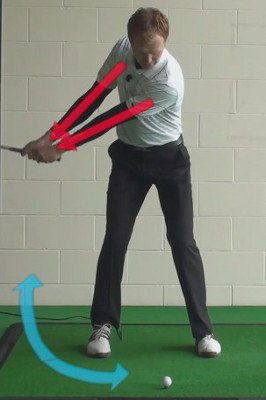Starting the golf swing properly is essential for setting up a solid foundation and establishing good mechanics throughout the entire swing. Here's a comprehensive guide on how to start the golf swing:
- Addressing the ball: The first step is to position yourself correctly at address. Start by standing with your feet shoulder-width apart and aligning them parallel to the target line. The ball should be positioned slightly forward of center in your stance for most shots. Bend your knees slightly, maintain a relaxed posture, and keep your weight balanced on the balls of your feet.

How To Start The Golf Swing Properly
- Grip: A proper grip is crucial for control and consistency. Place your left hand on the club, making sure the handle rests across the base of your fingers and diagonally across your palm. The “V” formed by your thumb and index finger should point toward your right shoulder. Wrap your right hand around the club, interlocking or overlapping your left index finger with your right pinky finger. Maintain a light grip pressure to allow for a free and fluid swing.
- Takeaway: The takeaway is the initial movement of the club away from the ball. Start by initiating the motion with your shoulders, rotating them away from the target while keeping your arms and wrists relaxed. The club should move low and along the target line, with the hands and wrists remaining passive. Avoid any sudden or jerky movements.
- One-piece takeaway: A key concept in starting the golf swing is the one-piece takeaway. This means that the club, arms, and shoulders move together as a unit in the early stages of the swing. Focus on keeping your arms and body connected and moving in sync to promote a smooth and controlled takeaway.
- Rotation and weight transfer: As you complete the takeaway, continue the rotation of your shoulders and torso, allowing your weight to shift to the inside of your right foot (for right-handed golfers). This movement helps to create torque and coil in your body, storing energy for the downswing. Maintain a stable lower body as you rotate, with minimal lateral movement.
- Backswing: Once you've completed the takeaway and achieved a proper rotation, continue the backswing by bringing the club up and over your right shoulder. Keep your wrists hinged and maintain a wide arc, allowing the club to swing on a correct plane. Avoid excessive tension in your arms and wrists, striving for a relaxed and fluid motion.
- Pause at the top: At the peak of your backswing, briefly pause to ensure proper positioning and balance. Your weight should be loaded onto the inside of your right foot, with your hips and shoulders fully rotated. Use this moment to check your alignment and mentally prepare for the downswing.
- Downswing: Initiate the downswing by shifting your weight onto your left side and starting the rotation of your hips and torso toward the target. Allow the club to drop naturally and follow the correct swing path, while maintaining good tempo and rhythm. Avoid rushing the downswing and maintain control throughout.
- Impact: The moment of impact is crucial for generating power and accuracy. Focus on maintaining a stable lower body and transferring your weight to your left side as you strike the ball. Keep your hands ahead of the clubhead at impact, ensuring a solid and crisp contact with the ball.
- Follow-through: Complete the swing with a full and balanced follow-through. Allow your body to continue rotating toward the target as the club swings around and over your left shoulder. The follow-through should be smooth and controlled, with a natural extension of the arms and a high finish.
Remember, practice and repetition are key to developing a consistent and effective golf swing. Work on these fundamental steps and seek guidance from a golf professional to refine your technique and address any specific swing faults or issues you may have. With time and dedication, you'll be able to start your golf swing with confidence and precision.






